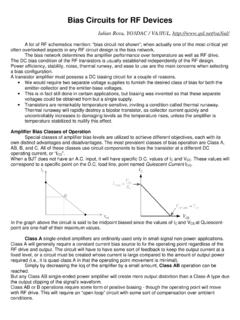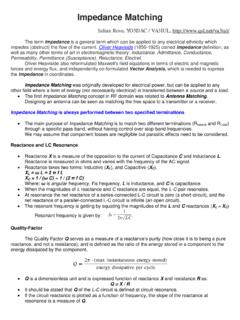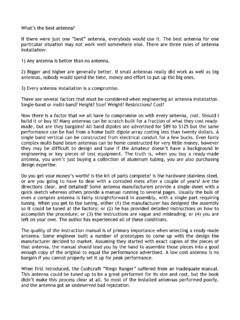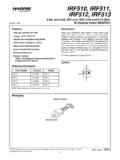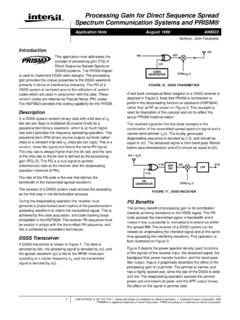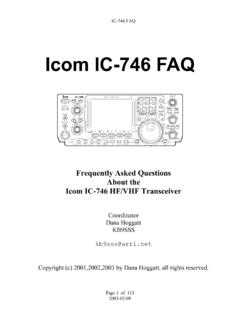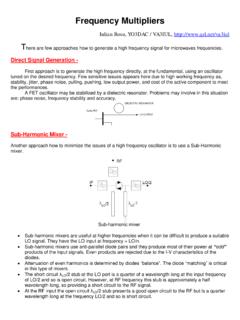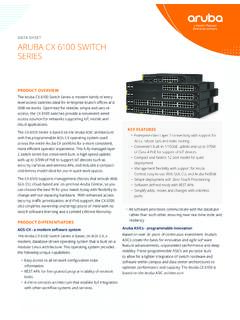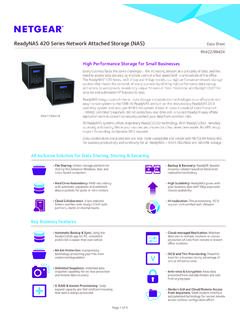Transcription of Automatic Gain Control (AGC) in Receivers - QSL.net
1 Automatic gain Control (AGC) in Receivers Iulian Rosu, YO3 DAC / VA3 IUL, Automatic gain Control (AGC) was implemented in first radios for the reason of fading propagation (defined as slow variations in the amplitude of the received signals) which required continuing adjustments in the receiver s gain in order to maintain a relative constant output signal. Such situation led to the design of circuits, which primary ideal function was to maintain a constant signal level at the output, regardless of the signal s variations at the input of the system. Now AGC circuits can be found in any device or system where wide amplitude variations in the output signal could lead to lose of information or to an unacceptable performance of the system. The main feature of a Control system is that there should be a clear mathematical relationship between input and output of the system. When the relation between input and output of the system can be represented by a linear proportionality, the system is called a linear Control system.
2 When the relationship between input and output cannot be represented by single linear proportionality, rather the input and output are related by some non-linear relation, the system is referred to as a non-linear Control system. Closed-Loop Control System Any system that can respond to the changes and make corrections by itself is known as a closed-loop Control system. Automatic gain Control (AGC) system is a closed-loop Control system. The main difference between open-loop and closed-loop systems is the feedback action. An open-loop Control system doesn't use a feedback action network, when a close-loop Control system uses feedback action. AGC using closed-loop Control are accurate, can use wide bandwidths, but may become unstable under certain conditions. An AGC Control system it adjusts itself to the changes in the system, providing a reduced effect of non-linearity in these systems. An AGC system is deterministic if the response is predictable and repeatable.
3 If not, the Control system is a stochastic Control system that involves random variable parameters. An AGC system is called dynamic or time-dependent if its present output depends on past input, whereas, a static system is the one whose current output depends only on the current input. Requirements of an Automatic gain Control (AGC) System Accuracy is the measurement tolerance of the instrument and defines the limits of the errors made when the instrument is used in normal operating conditions. Accuracy can be improved by using feedback elements. To increase the accuracy of any AGC system, an error detector should be present in the Control system. The parameters of an AGC system are always changing with the change in surrounding conditions, internal disturbance or any other parameters. This change can be expressed in terms of Sensitivity. Any AGC system should be insensitive to such parameters, but sensitive to input signals only.
4 An undesired input signal is known as Noise. A good AGC system should be able to reduce the noise effect for better performance. Stability it is an important characteristic of the AGC system. For the bounded input signal, the output must be bounded and if the input is zero then the output must be zero then such an AGC system is said to be a stable system. The time response and the operating frequency range decides the Bandwidth of the AGC system. Bandwidth should be as large as possible for the frequency response of a good AGC system. However, in a receiver could exist more AGC Control -loops, each having different bandwidths, so different frequency responses. Speed it is the time taken by the AGC system to achieve its stable output. A good AGC system possesses high speed, but sometime low speed is required. The transient period for high speed AGC system is very small, when for a low speed AGC the transient period is high.
5 A small number of Oscillation or constant oscillation of output tends to indicate the system to be stable. Automatic gain Control (AGC) circuits are employed in many systems where the amplitude of an incoming signal can vary over a wide dynamic range. The role of the AGC circuit is to provide a relatively constant output amplitude so that circuits following the AGC circuit require less dynamic range. If the signal level changes are much slower than the information rate contained in the signal, then an AGC circuit can be used to provide a signal with a well-defined average level to downstream circuits. In most system applications, the time to adjust the gain in response to an input amplitude change should remain constant, independent of the input amplitude level and hence gain setting of the amplifier. The large dynamic range of signals that must be handled by most Receivers requires gain adjustment to prevent overload or IM of the stages and to adjust the demodulator input level for optimum operation.
6 A simple method of gain Control would involve the use of a variable attenuator between the input and the first active stage. Such an attenuator, however, would decrease the signal level, but it would also reduce the S/N of any but the weakest acceptable signal. A typical AGC loop circuit is shown in the picture below. This is a feedback system comprising a forward controlled gain stage, feedback gain and a signal comparison stage that generates a differential error signal. The AGC loop is analyzed in terms of its closed loop gain (forward transfer function) and open loop gain . There is temperature compensation at the detector diode stage to compensate for diode detector forward voltage variation with temperature. gain Control is generally distributed over a number of stages, so that the gain in later stages (the IF amplifiers) is reduced first, and the gain in earlier stages (RF and first IF) is reduced only for signal levels sufficiently high to assure a large S/N.
7 If the RF gain is small is enough switching in/out an attenuator at RF only for sufficiently high signal levels. Variable gain Control for the later stages can operate from low signal levels. Variable- gain amplifiers are controlled electrically, and when attenuators are used in Receivers , they are often operated electrically either by variable voltages for continuous attenuators or by electric switches (relays or diodes) for fixed or stepped attenuators. AGC Block Diagram The input signal is amplified by a Variable gain Amplifier (VGA), whose gain is controlled by an external signal VC. The output from the VGA can be further amplified by a second stage to generate and adequate level of Vo. Some the output signal s parameters, such as amplitude, carrier frequency, index of modulation or frequency, are sensed by the detector; any undesired component is filtered out and the remaining signal is compared with a reference signal.
8 The result of the comparison is used to generate the Control voltage (Vc) and adjust the gain of the VGA. If the Control time constants are determined primarily by the detector circuit and the additional amplifier has a wider bandwidth than the detector, then the attack and decay times will be shortened by the amount of the post-amplification An AGC circuit in the receiver provides a substantially constant signal level to the demodulator independent of the input signal level. AGC Ideal transfer Function For low input signals the AGC is disabled and the output is a linear function of the input, when the output reaches a threshold value (V1) the AGC becomes operative and maintains a constant output level until it reaches a second threshold value (V2). At this point, the AGC becomes inoperative again; this is usually done in order to prevent stability problems at high levels of gain . If the gain loop is much greater than 1, the steady state change in the input is greatly reduced.
9 AGC Real transfer Function The line A, B, C represents a system that has no AGC applied. The output increases linearly with the input signal until point B is reached, when some element in the signal chain overloads and becomes non-linear. Generally, from point B to C the output signal is distorted and, unless the input signal is reduced, the system is unusable. Increasing this value increases the slope of the line A to B and reduces the input signal level at which the signal distorts. The line A, D, E represents a system that has AGC applied. The slope A, D is greater than unity and indicates that the AGC has gain prior to the AGC detector. The transition from a linear to constant output at D is known as the AGC knee or threshold. From D to E the output level does not increase in response to an increase in input signal. How flat the section of the line D to E is depends on the overall AGC loop gain and is called the AGC Slope.
10 The AGC knee should not be set at too low input level. Above the AGC knee the AGC characteristics should be not flat, and must have a slope between 6dB and 10dB. The AGC system is basically a feedback amplifier and has a closed-loop gain characteristic, which is essentially low-pass. AGC systems that include a reference voltage inside the Control loop are referred as delayed AGC. Many direct conversion Receivers do not use AGC. The advantages of not using AGC are simplicity and the purity of the received signal, in that weak received signals sound weak and strong signals sound loud. An incorrectly designed AGC system can introduce considerable distortion to an otherwise clean signal. Within the noise and distortion limits of the VGA, the AGC loop is set up to provide both signal amplification and compression to maintain the output signal within the specified limits. If you need lower second-harmonic distortion, consider lowering the maximum AGC input level at the expense of dynamic input range.
